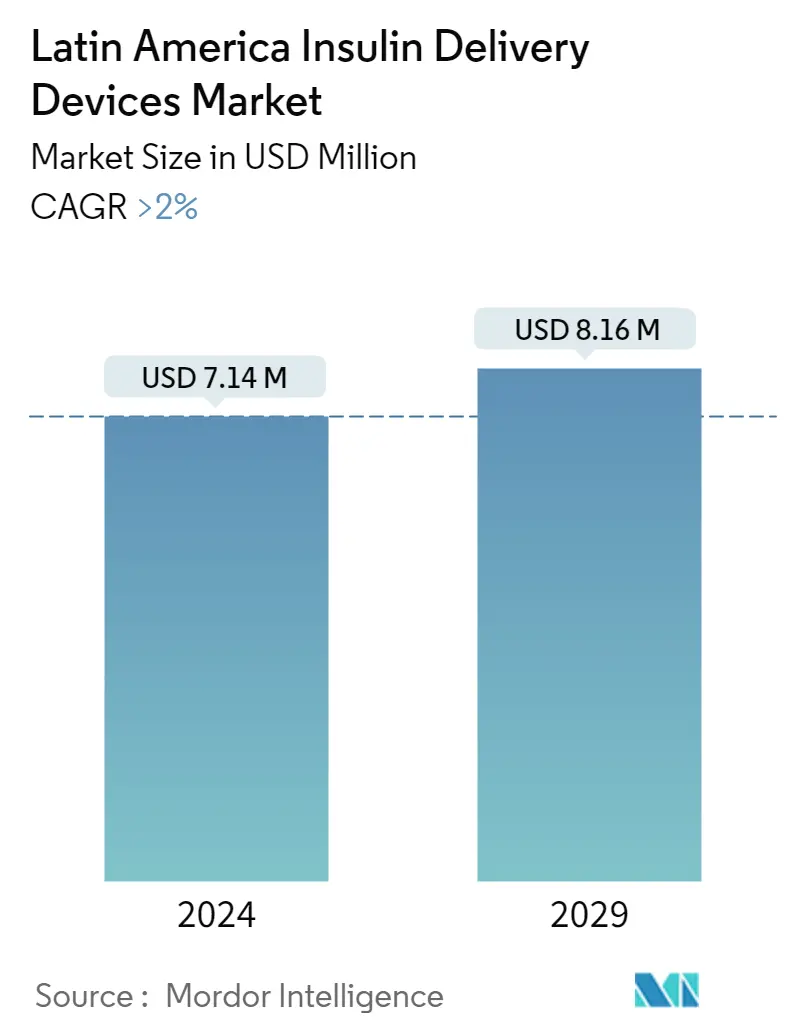Market Size of Latin America Insulin Delivery Devices Industry

| Study Period | 2019 - 2029 |
| Base Year For Estimation | 2023 |
| Forecast Data Period | 2024 - 2029 |
| Market Size (2024) | USD 7.14 Million |
| Market Size (2029) | USD 8.16 Million |
| CAGR (2024 - 2029) | 2.00 % |
Major Players
*Disclaimer: Major Players sorted in no particular order |
Latin America Insulin Delivery Devices Market Analysis
The Latin America Insulin Delivery Devices Market size is estimated at USD 7.14 million in 2024, and is expected to reach USD 8.16 million by 2029, growing at a CAGR of greater than 2% during the forecast period (2024-2029).
The pandemic that everyone was talking about before COVID-19, is a challenge to health systems and a threat to their financial viability. The improper use of corticosteroids and the presence of diabetes mellitus in patients during the Coronavirus Disease 2019 (COVID-19) pandemic marked the beginning of an increased incidence of fungal infections such as aspergillosis and mucormycosis in patients with this emerging viral infection. More than 200 cases have been reported in the literature in Latin America, ranging from Mexico to Argentina. The majority of cases have come from Brazil. Prior to COVID-19, the number of cases had been increasing while the mortality rate had been decreasing. Access to telemedicine is critical for managing chronic diseases in children, such as type 1 diabetes.
Telemedicine was implemented in Latin American countries due to the COVID-19 pandemic, which positively impacted the health system. Telemedicine could result in financial savings by avoiding transportation expenses, class and parental working hours lost, time lost for transportation to distant referral health centres, and improving the quality of life, socioeconomic level, and environment."
Diabetes is one of the major health challenges of the twenty-first century, according to the Pan American Health Organization (PAHO). According to the organization's data, the number of people suffering from this condition will reach 642 million by 2040. One advantage of this solution is that it allows patients to communicate with a remote healthcare professional, avoiding the need to visit a healthcare facility and lowering the risk of contracting COVID-19 in this high-risk group. Diabetes affects approximately 41 million people in Latin America and 400 million worldwide. This figure is expected to rise over time, reaching 68 million diabetics in the region by 2040.
Technological advancements have increased over the period in Insulin delivery devices for safer and more accurate administration of insulin. In 2020, Medtronic launched its first integrated smart insulin pen. The Medtronic Integrated Insulin Pen provides real-time glucose readings of patients along with insulin dose information to manage their glucose levels.
The world is facing an unprecedented global health crisis, and it is critical that we support the implementation of technological solutions, such as Insulin devices, to collaborate on regional growth and continue to support the millions of people living with this condition.
Latin America Insulin Delivery Devices Industry Segmentation
There are several choices for delivering insulin to people with diabetes, including syringes, pens, pumps, and jet injectors. A syringe is a tool having a detachable needle guard, plunger, and hollow center. Latin America Insulin Delivery Devices Market is segmented by Device (Insulin Pumps, Insulin Syringes, Cartridges in Reusable Pens, Disposable Pens, Jet Injectors) and Geography (Mexico, Brazil, and the Rest of Latin America). The report offers the value (in USD) and Volume (in Unit) for the above segments. We will provide a segment-wise breakdown (Value and Volume) for all the countries covered under the Table of Contents.
| Device | |||||||||||
| |||||||||||
| |||||||||||
| Insulin Syringes | |||||||||||
| Jet Injectors |
| Geography | |
| Brazil | |
| Mexico | |
| Rest of North America |
Latin America Insulin Delivery Devices Market Size Summary
The Latin America insulin delivery devices market is poised for growth, driven by technological advancements and increasing diabetes prevalence in the region. The market is characterized by the introduction of innovative devices such as smart insulin pens and insulin pumps, which offer safer and more accurate insulin administration compared to traditional methods. The adoption of telemedicine during the COVID-19 pandemic has further enhanced the management of chronic diseases like type 1 diabetes, providing patients with remote access to healthcare professionals and reducing the risk of virus transmission. Brazil is expected to lead the market due to its extensive healthcare programs, high consumer awareness, and government initiatives to support diabetes management.
The competitive landscape of the insulin delivery devices market in Latin America is consolidated, with a few major global and regional companies dominating the scene. Key players include Novo Nordisk, Sanofi, Eli Lilly and Company, Medtronic, Insulet, Ypsomed, and Becton Dickinson and Company. These companies are actively involved in launching new products and expanding their market presence. For instance, Medtronic's integrated smart insulin pen and Insulet's Omnipod 5 system highlight the ongoing innovation in the sector. Despite challenges such as healthcare professional shortages and the need for improved access to medical care, the market is expected to grow, supported by technological solutions and strategic partnerships.
Latin America Insulin Delivery Devices Market Size - Table of Contents
-
1. MARKET DYNAMICS
-
1.1 Market Overview
-
1.2 Drivers
-
1.3 Restraints
-
1.4 Porter's Five Forces Analysis
-
1.4.1 Bargaining Power of Suppliers
-
1.4.2 Bargaining Power of Consumers
-
1.4.3 Threat of New Entrants
-
1.4.4 Threat of Substitute Products and Services
-
1.4.5 Intensity of Competitive Rivalry
-
-
-
2. Market Segmentation
-
2.1 Device
-
2.1.1 Insulin Pump
-
2.1.1.1 Technology
-
2.1.1.1.1 Tethered Insulin Pump
-
2.1.1.1.2 Tubeless Insulin Pump
-
-
2.1.1.2 Component
-
2.1.1.2.1 Insulin Pump Devices
-
2.1.1.2.2 Insulin Pump Reservoirs
-
2.1.1.2.3 Infusion Sets
-
-
-
2.1.2 Insulin pens
-
2.1.2.1 Cartridges in reusable pens
-
2.1.2.2 Disposable Pens
-
-
2.1.3 Insulin Syringes
-
2.1.4 Jet Injectors
-
-
2.2 Geography
-
2.2.1 Brazil
-
2.2.2 Mexico
-
2.2.3 Rest of North America
-
-
Latin America Insulin Delivery Devices Market Size FAQs
How big is the Latin America Insulin Delivery Devices Market?
The Latin America Insulin Delivery Devices Market size is expected to reach USD 7.14 million in 2024 and grow at a CAGR of greater than 2% to reach USD 8.16 million by 2029.
What is the current Latin America Insulin Delivery Devices Market size?
In 2024, the Latin America Insulin Delivery Devices Market size is expected to reach USD 7.14 million.

